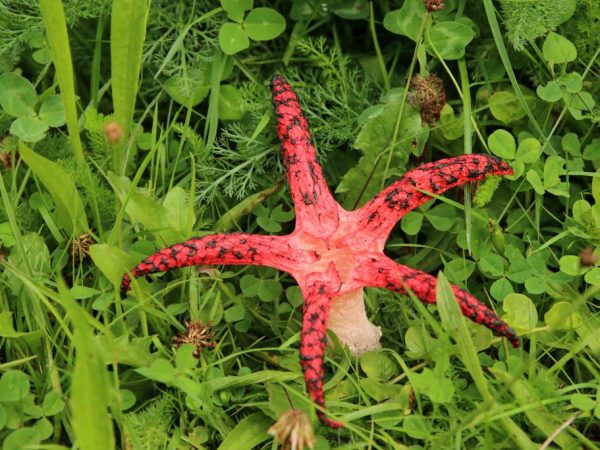Is it possible to eat the Devil's Fingers mushroom
Anthurus Archer mushroom looks very similar to an octopus, albeit with four tentacles. His appearance is disgusting for many, but mycologists are crazy about him.

Is it possible to eat the Devil's Fingers mushroom
Description of the mushroom
Anturus Archera belongs to the Veselkov family, the Reshetochnik family. It is popularly called the Fingers of the Devil. It is also called cuttlefish, octopus, or better yet, the Devil's Hand. in what, but in fantasy and imagery of thinking, the inhabitants of the planet Earth from different countries are magnificent.
For representatives of the species, the ability to change the appearance depending on the stage of development in the process of the life cycle is inherent. Initially, it appears in the form of an egg with a diameter of no more than 6 cm - this is how a young fruiting body looks like. During this period, it can be easily confused with toadstools, the results of natural abortion of baby animals and other strange objects. The Devil's fingers are represented by the following components of the body:
- the core - the developing components of the adult organism of the fungus, covered with a mucous, jelly-like membrane;
- peridium - the outer shell of a whitish or grayish color and a pinkish or brown tint, which, after the release of the receptacle from it, remains at the base of the fruiting body;
- long filamentous strands that supply the body with nutrients.
The Devil's Fingers mushroom is in this state until it “blooms”.
Irina Selyutina (Biologist):
Anturus Archera belongs to the order Gasteromycetes and is characterized, like all of them, by the closedness of their fruiting bodies until the ripening of the basidiospores. Ripe basidiospores are separated from unicellular basidia under the surface of the envelope, which made it possible to give such mushrooms another name - nutreviki. The release of basidiospores from the fruiting body occurs only after rupture or complete destruction of the shell of the fruiting body.
The mycelial strands, characteristic of gasteromycetes, help a significant coverage of the territory and contribute to the spread of the fungus.
From late July to mid-October, the egg loses its shell and pulls out no more than 8 "tentacle petals", more often - 4. Their apex seems to be fused together. Each "petal" -lope, which is part of the recipe, reaches 15 cm in length. Further, the "petals" are separated and become similar to the tentacles of an octopus. They have a fragile structure, covered with black spots - areas of mucous spore-bearing gleb, which, with its pungent unpleasant odor, attracts spore-spreading insects.
This type of mushroom has no legs. The specific smell attracts flies and other insects. They spread the spores and begin to multiply the fungus.
The method of reproduction is completely different from other types of mushrooms, except for the representatives of the Veselkovye family. After the body has lost the shell-egg, the Devil's Fingers does not live long, 2-3 days. This period is enough for the insects to spread the spores.
Anturus Archer is classified as a rare species. It is listed in the Red Data Books of a number of countries around the world.
Geography of distribution

In Russia, the mushroom is very rare.
The Devil's Fingers mushroom came from New Zealand and Australia (Tasmania). Then it spread to the countries of Africa, Asia, America.
There is no exact information about when this species was introduced to Europe. According to some reports, this happened in 1914-1920. in bags of wool, which was delivered to the French light industry.
In the 30s. XX century. The Devil's Fingers was first found in Germany. In the 40s, it was found in other European countries, for example, Switzerland, Austria, England. A few years later he was found on the Baltic coast. In the Soviet Union, it was first found in Kazakhstan, then in the Ukrainian Carpathians (1977). On the territory of Russia, fruiting bodies were first recorded in 1978.
In Russia, the Devil's Fingers mushroom grows extremely rarely, the last time it was seen in the Kaluga region. Most of its distribution is concentrated in the UK, Poland, the Baltic.
Anthurus Archera is a mushroom that loves humus soil, rotting wood, desert or semi-desert terrain. It was also found in mixed and deciduous forests. He grows alone or in a group.
Application
The Devil's Fingers is an inedible mushroom due to its taste and aroma. Its appearance and fetid odor take away any desire to taste the product.
This type is not used in cooking. It is also not used in scientific and folk medicine.
Function in nature
The Devil's fingers are not a predator. He does not eat insects or small animals. They only help him spread spores and therefore establish new colonies in places more distant from the parental specimens.
During the main growth period, during the "slimy egg" stage, it can be easily confused with a white toadstool. In this case, the Devil's Fingers is harmless, and the white toadstool is fatal.
Conclusion
Anturus Archer is an inedible species. It has a nasty taste, the stench of a decaying mass of animal origin and a long nasty aftertaste (as the daredevils who dare to try it say). However, they cannot be poisoned or sick after consuming it.
Devil's fingers at an early stage of development are outwardly somewhat similar to the white toadstool, but this mushroom does not pose a mortal threat.



